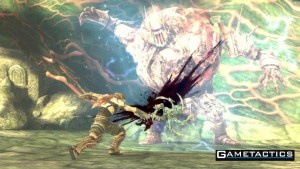 Ever since Capcom decided to pass up the Vita in favor of the 3DS for its next release of the Japanese Action RPG megahit, Monster Hunter, people have been wondering how Sony would respond. And when Keiji Inafune, co-designer of Mega Man, left his position as Capcom’s Global Head of Production, many in the industry speculated about what his next move would be. In Soul Sacrifice for the Playstation Vita we have the final product of these two seemingly disparate events. The question is whether it will be enough to catch the eye of diehard fans of the genre who are a significant part of the market in Japan, and if it helps to fill the continuing gap of unique, standout AAA exclusives in the Vita’s library to appeal to the mass market in general.
Ever since Capcom decided to pass up the Vita in favor of the 3DS for its next release of the Japanese Action RPG megahit, Monster Hunter, people have been wondering how Sony would respond. And when Keiji Inafune, co-designer of Mega Man, left his position as Capcom’s Global Head of Production, many in the industry speculated about what his next move would be. In Soul Sacrifice for the Playstation Vita we have the final product of these two seemingly disparate events. The question is whether it will be enough to catch the eye of diehard fans of the genre who are a significant part of the market in Japan, and if it helps to fill the continuing gap of unique, standout AAA exclusives in the Vita’s library to appeal to the mass market in general.
Fitting for a game titled Soul Sacrifice, the setting and story are especially grim, which may turn off those looking for a fun romp in the wilderness. Instead you are introduced to a dark hellscape, about to be sacrificed by a cruel and all powerful sorcerer named Magusar. Your only hope is demon book that suddenly appears in your cell cage that goes by the name of Librom. This talking book explains that your only hope out of your predicament is to read his contents, which detail past events and battles in the life of another sorcerer who was a partner of Magusar’s. Through re-enacting this story you will learn about the universe you inhabit and in the process make yourself more powerful in order to take on Magusar. Librom makes it clear that you’re not the first to attempt this and is pessimistic about your prospects to boot. You can actually choose to fight Magusar at any time, though it’s obviously suicidal until you’ve at least cleared the story. Anyhow, the basic concept of this world is that there is an organization of sorcerers called Avalon which is commissioned to destroy monsters that overrun the land. It turns out that the most powerful archfiend monsters are former sorcerers themselves, which have become corrupted by evil, and you become intimately familiar with this process as you trace the pages of Librom’s journal.
This central concept ties into several unique gameplay mechanics in Soul Sacrifice. At first glance, it’s simply a more linear Monster Hunter in which you fight monsters and archfiends in battle arena after battle arena. It all takes place in third person, and you attack by casting various spells which are assigned from your inventory to each button before battle, with the X button being reserved for dodging, the L button to lock on a target (which jumps to the nearest enemy far too easily for my tast), the R button for cancelling spells , and down on the d-pad to turn on Mind’s Eye, which reveals information on your surroundings like environmental buffs and the health and weakspots of enemies and allies. The real twist comes in what you do once you defeat your enemies, or even when your allies are killed, for each time this occurs, you must choose either to save or sacrifice them. Saving an enemy restores your health, while sacrificing them recharges your offerings or spells (that’s right, each of your spells has a specific number of uses during battle before it breaks unless you recharge them). Saving an ally meanwhile transfers half of your health to the other person, but sacrificing them on the other hand unleashes a huge, powerful spell that damages all monsters on the map. These decisions factor into leveling your character as your abilities are split between Life and Magic, the former of which is boosting by saving souls of course and the latter by sacrificing them. Your character goes through 100 of these levels, and if you hit either 90 Life or 90 Magic you will transform into Chaos Mode and Holy Mode, respectively, incredibly altering your appearance. If you max out either then you will attain the Level 2 appearance of each mode. However your gameplay style may dictate a balance between the two sides; it’s all up to you. Life leveling increases your health and defense while Magic leveling increases the damage of your spells.
Speaking of spells, there’s a whopping 32 categories of them. For starters there’s attack offerings like Blood, which drains your health for a machine gun type effect, homing of fire and ice, morphing attacks, mortars that fire in an arc, and even giant arms of rock, ice, or lava to melee with. Then you have the support offerings which can heal yourself or others, increase defense, etc. And finally there’s special offerings that increase evasion, slow time within an area, or duplicate other offerings. On top of that you have sigils, which are passive stat increases to your HP, attack power, defense, etc. that you carry on your right arm and unlock as you increase levels and capture life or soul essences from monsters you save or sacrifice, respectively. Last but not least, there’s another set of last ditch effort spells you can cast at a great sacrifice to your own body and abilities, called the Black Rites. These unlock as you level up in either the Life or Magic categories and do things like sacrificing your skin to hit all enemies on the map with a blanket of flame, halving your defense in the process, or one shot an enemy at the price of periodic health loss. These Rites are retained after battle and can only be removed through the use of Lacrima, tears excreted by Librom over time which allow you to erase certain decisions made both in this and in leveling. This kind of undermines the difficult decisions you’re supposed to be making throughout the game, but in my opinion at least encourages more exploration of the options without being doomed to a bad choice. It does keep you from reversing every decision instantly, at least.
Besides the main story, there’s also side quests called Avalon Pacts that you can play. This is where multiplayer comes into play if you choose to participate in it. The main difference being that your normally dreadful AI allies are replaced with humans that hopefully know what they’re doing, and if you’re the one that’s doing poorly, your allies may decide to sacrifice you for their own benefit. Once sacrificed you will not only unleash damage on all the enemies, but you will turn into a ghost who can see everyone’s health bars, info that is normally hidden within the game, as well as weaken enemy defenses and boost ally’s attack powers. Unfortunately you also lose out on the spoils of battle should this occur, making the online mode possibly cutthroat than fully cooperative (there is an ability to set a room policy advertising whether beginners are welcome or whether you prefer hard core players, but who knows how truthful people are).
The single player mode is rather harsh and demanding in itself. While it starts out easy enough to ease you into the controls and combat, the difficulty curve becomes steep and the archfiend battles unforgiving. Bosses have so much health and can be so hard to figure out how to damage that you can easily spend a half hour or so on a battle, only to lose and have to start over from scratch, with very little feedback on how close you were to succeeding since the game lacks health bars. Your only clue is in the floating words of dialogue from the monster and a change in its tactics. Also, while you can choose up to six offerings to use in battle, often times you’ll find yourself with spells that are completely useless against the particular enemies you face, leading to a lot of trial and error. Of course the good side of all this struggle can be the sense of accomplishment you feel when you finally take an archfiend down. Then you get to agonize whether to save or sacrifice them, depending on how you want to build your character. All in all, this isn’t a game for the faint of heart but more for the contingent that actually enjoy Dark Souls.
The one element of Soul Sacrifice you certainly can’t knock is the visuals. It may not be the most technically brilliant you’ll find on the Vita, but the character and monster designs are inspired and original, really giving the feel of the complete corruption that’s oozing throughout the world. There’s more color than you would expect in some of the environments given the theme, however, and it all runs pretty smoothly. The music compliments the menus and action quite well, adding to the epic, ghoulish feel of the game. Finally, the voice acting has a decidedly British flair that lends an air of gravity to the story, while Librom himself is rather funny as he protests your treatment of him and jokes about the downsides of being a book, which adds back a bit of levity and character to the proceedings.
I’ll be honest. This isn’t really my type of game, both in theme and difficulty, but I was impressed in various ways all the same. It’s hard to recommend to outsiders of the genre like myself, as it’s far too punishing and has too many little quirks that will make less determined gamers throw in the towel. But for those looking for a deep and difficult experience that don’t mind putting up with the challenges of the controls and spending hours learning all the bosses and spells, it should be their cup of tea. There’s also the replay value of being able to rebuild and play your character in dozens of different ways. The only thing that may turn off veterans of monster hunting and the like is the fact that the game is far more linear and takes place in small arenas, not an open world. I would say Keiji Inafune succeeded for the most part in designing a unique and interesting game concept, but it’s up to Sony to turn it into something that can carry a platform from here.
Gameplay
Graphics
Sound
Overall

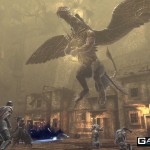

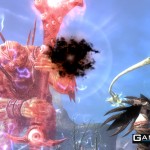



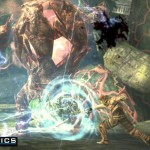
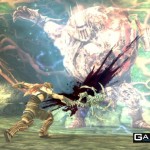


One Response